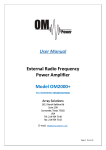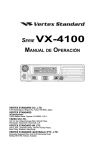Download Vertex Standard VXR-7000 Specifications
Transcript
VXR-7000 Operating Manual VERTEX STANDARD CO., LTD. 4-8-8 Nakameguro, Meguro-Ku, Tokyo 153-8644, Japan VERTEX STANDARD US Headquarters 17210 Edwards Rd., Cerritos, CA 90703, U.S.A. International Division 8350 N.W. 52nd Terrace, Suite 201, Miami, FL 33166, U.S.A. YAESU EUROPE B.V. P.O. Box 75525, 1118 ZN Schiphol, The Netherlands YAESU UK LTD. Unit 12, Sun Valley Business Park, Winnall Close Winchester, Hampshire, SO23 0LB, U.K. YAESU GERMANY GmbH Am Kronberger Hang 2, D-65824 Schwalbach, Germany YAESU HK LTD. 11th Floor Tsim Sha Tsui Centre, 66 Mody Rd., Tsim Sha Tsui East, Kowloon, Hong Kong Contents Introduction ..................................................................................................................................1 Controls & Connectors ...............................................................................................................2 Front Panel .................................................................................................................................. 2 Rear Panel ................................................................................................................................... 3 ACC Connector Port ...................................................................................................................4 LINE Interface Port .....................................................................................................................6 Installation ....................................................................................................................................7 Antenna Considerations ............................................................................................................ 7 AC Power Supply Voltage Selection......................................................................................... 7 DC Power Supply Backup ......................................................................................................... 7 Equipment Location .................................................................................................................. 7 Changing Switching Regulator unit AC Mains Jumper Wiring ....................................... 8 CE27 Programming Software Instruction .......................................................................... 10 Channel Data Items ................................................................................................................. 11 Duplexer Installation .............................................................................................................. 14 Specifications ............................................................................................................................ 16 Accessories ................................................................................................................................. 17 Introduction The VXR-7000 is commercial quality 50-watt FM repeater designed to provide reliable, continuous-duty two-way communications over a wide range of environmental conditions. Designed to be a stylish base station, with high-grade components utilized throughout, the VXR-7000 utilizes the latest computer-aided design and manufacturing processes to ensure a high level of reliability for users. Important channel frequency data is stored in EEPROM, and is easily programmable by a Servicing Technician or Dealer using an IBM compatible personal computer and the VPL-1 Programming Cable and CE27 Software. Please take a few minutes to read this manual carefully. The information presented here will allow you to derive maximum performance from your VXR-7000. After reading it, keep this manual handy for quick reference, in case questions arise later on. Important Note: Internal service work, programming, and accessory installations should only be performed by your authorized Vertex Standard Dealer. Dangerous conditions and/or possibly illegal operation may result from improper setup, programming, or internal modifications. IMPORTANT NOTICE To comply with FCC RF exposure compliance requirements, the following antenna installation and device operating configurations must be satisfied: The device is to be installed and operated at a “fixed location.” The term “fixed location” means that the device is physically secured at one location and is not able to be easily moved to another location. The antenna system to be used with this device must be installed outdoors, on a permanent structure, such that a minimum separation of 6 meters (19.7 feet) is maintained from any area where persons may be walking, sitting, and/or working. If the above antenna requirements are followed, this FCC device is considered categorically excluded from routine RF exposure evaluation for demonstrating compliance. The installer of the antenna to be used with this device may be required to perform an MPE evaluation and an Environmental Assessment (EA) of the location at the time of licensing per CFR 47 Part 1.1307. Fixed mounted antennae that are co-located with other antennae must satisfy the co-location requirements of Part 1.1307. Important Notice for North American Users Regarding 406 MHz Guard Band The U.S. Coast Guard and National Oceanographic and Atmospheric Administration have requested the cooperation of the U.S. Federal Communications Commission in preserving the integrity of the protected frequency range 406.0 to 406.1 MHz, which is reserved for use by distress beacons. Do not attempt to program this apparatus, under any circumstances, for operation in the frequency range 406.0 - 406.1 MHz if the apparatus is to be used in or near North America. VXR-7000 FM R EPEATER OPERATING M ANUAL 1 Controls & Connectors Front Panel ① POWER Switch This is the main power switch for the repeater. ② LED Indicators AC: This LED glows green during AC operation. DC: This LED glows yellow during DC operation. ③ MIC Jack This 8-pin modular jack accepts the microphone input, and provides a standby control line to activate the transmitter when using the “BASE” mode of operation. This jack also provides a “Hook” control line, as well as a “Clone Data” line. ④ BASE/REPEATER Switch This switch toggles the operating mode between the “REPEATER” mode and the “BASE” transceiver mode. When the “REPEATER” mode is selected, the LED above it glows green. While in the “BASE” mode (the green LED is off), you can speak into the microphone to use it as a transceiver. For normal repeater operation, set this switch to the “REPEATER” mode. ⑤ LOCAL/REMOTE Switch This switch toggles the control mode between the “REMOTE” mode and “LOCAL” mode. When the “LOCAL” mode is selected, the LED above it is off, and the repeater operates according to the control data programmed into the repeater. While in the “REMOTE” mode, the LED glows green, and the repeater operates according to the control instructions received from an external device (connected to the ACC jack on the rear panel). 2 ⑥ MONITOR Switch This switch selects the “Squelch” (receiver mute) mode. When the green LED above it is off, “Tone” or “Coded” squelch is active. When you press this switch momentarily, the green LED will glow steadily; in this condition, only “noise squelch” is active, and any signal present on the channel will be heard. If you press and hold this switch for more than 2 second, the green LED will blink and the squelch will open; in this condition, background noise will be heard if no signal is present. ⑦ ACCESSORY Switch This switch can be set up for special applications, such as High/Low power selection, as determined by your Vertex Standard dealer. The LED above it glows green when this function is activated. For further details, contact your Vertex Standard dealer. ⑧ VOL Knob This control knob adjusts the receiver volume level from the front panel speaker. If desired, this control knob may be set fully counterclockwise when repeater monitoring is not needed. ⑨ SQL Knob This control knob selects the noise squelch threshold level. Set it to a position just above the point where the BUSY lamp goes out when no signal is present. ⑩ Channel Selector Buttons (p and q) Press one of these buttons to select the operating channel. VXR-7000 FM R EPEATER OPERATING M ANUAL Controls & Connectors ⑪ Channel Indicator ⑭ ANI RESET Button This seven-segment LED indicates the operating channel number. ⑫ ANI Display The ANI LCD (Liquid Crystal Display) indicates the pre-programmed ANI message according to the ANI code received. ⑬ TX/BUSY Indicator (1) ANI Press this button to clear the message on the ANI display, and turn off the LCD backlight. (2) ENI Press this button to turn off the Alert tone. Press this button again to clear the message on the ANI display, and turn off the LCD backlight. The BUSY indicator glows green when the channel is busy, and the TX indicator glows red when the repeater is transmitting. Rear Panel ① EXT SP Jack This 3.5-mm, 2-pin jack provides variable audio output for an external speaker. The audio output impedance at this jack is 4 Ω ~ 16 Ω, and level varies according to the setting of the front panel’s VOL control. ② TX Antenna Jack This N-type coaxial jack provides the transmitting output signal for connection to the transmitting antenna or TX jack on the duplexer, if used. The output impedance requirement is 50 Ω. ③ RX Antenna Jack This N-type coaxial jack accepts the receiver input signal from the receiving antenna or RX jack on the duplexer, if used. The input impedance requirement is 50 Ω. ④ ACC Jack This DB-25 connector provides a data interface between the microprocessor in the VXR-7000 and peripheral devices (such as the VX-TRUNK Unit). VXR-7000 FM R EPEATER OPERATING M ANUAL ⑤ LINE Jack This 8-pin modular jack is used for remote control. It provides TX and RX audio, TX keying, and squelch status output. The TX and RX audio impedance is 600 Ω. ⑥ GND Terminal For best performance and safety, the GND terminal should be connected to a good earth ground using a short, heavy, braided cable. ⑦ AC Jack This receptacle accepts the AC power cord, which should be connected to the AC mains supply or wall outlet. The AC line voltage must match that for which the repeater is wired. ⑧ BATT Terminal These terminal posts accept 12~ 15 VDC for operating the repeater from a battery or other DC source. When operating from AC mains, a small trickle current is present at these terminals to maintain battery charge. A battery rated for 12 volts, 55 Ah (minimum) is recommended for short-term emergency/ backup operation. Never short-circuit these terminal while operating from AC mains. 3 ACC Connector Port The VXR-7000 repeater is provided with a 25-pin DB25F female connector for interconnections to accessories. Use a DB-25M 25-pin male connector to connect accessories to the repeater. The pins on the accessory connector are explained in detail as follows: Pin 1: GND Chassis ground for all logic levels and power supply return. Pin 8: RSSI [Analog Output] A DC voltage proportional to the strength of the signal currently being received (Receiver Signal Strength Indicator) is provided on this pin. This low impedance output is generated by the receiver IF sub-system and buffered by an internal op-amp. Typical voltages are graphed as follows: Pin 2: +13.8 V [Power Supply] This pin provides 13.8 Volts, 1.0 A, regulated DC from the repeater supply. Use a 1 A fuse in the external device’s DC line to prevent damage to the repeater. Pin 3: TX AF IN [Analog Transmitter Input] (Voice Band: 300 ~ 3,000 Hz) Input impedance is approx. 600 Ω. This audio is injected before the splatter filter stage, so excess signal input levels are clipped. Use shielded cable to connect to this pin, and connect the shield to GND. Pin 4: TONE IN [Transmitter Input] (Sub-audible Band: 6 ~ 250 Hz) The input is high impedance (approx. 22 kΩ). Injecting too high a voltage here causes over-deviation of CTCSS or DCS, degrading performance. Use shielded cable to connect to this pin, connecting the shield to GND. Pin 5: N.C. (No connection.) Pin 6: DISC OUT [Analog Output] (Wide-Band: 0 ~ 3,000 Hz) Received signals with standard deviation produce approx. 1 Vp-p audio at this pin. The output impedance is approx. 600 Ω, and is extracted before the de-emphasis and squelch circuitry. Use shielded cable to connect to this pin, and connect the shield to GND. Pin 9: COAX. SW [Logic Output (Active Low)] This output is intended for controlling an external coaxial switching relay. It is an open collector output which can sink approx. 10 mA when active. This signal only switches if the repeater has been programmed for “SIMPLEX” mode. If programmed for “DUPLEX,” the signal remains open (high impedance) at all time. Pin 10: N.C. (No connection.) Pin 11: NSQ DET This is an open-collector, active-low output capable of sinking about 10 mA. It indicates that the receiver squelch is open. If the squelch control is properly set, this indicates a carrier on the receiver channel. Pin 12: EXT PTT This input is internally pulled up to 5 VDC. When pulled low by an external device, it keys the repeater transmitter while the repeater is operating in the “BASE” mode. Avoid voltage in excess of 5 V on this pin, or internal damage to the microprocessor on the repeater CNTL Unit may result. Pin 7: GND Chassis ground for all logic levels and power supply return. ACC Jack DB-25 Pin Numbering 4 VXR-7000 FM R EPEATER OPERATING M ANUAL ACC Connector Port Pin 13: GND Chassis ground for all logic levels and power supply return. Pin 20: GND Chassis ground for all logic levels and power supply return. Pin 14: GND Chassis ground for all logic levels and power supply return. Pin 21: A-OUTPUT [Logic Output] (Active Low) This open collector logic output is pulled low when the front panel’s ACCESSORY key is turned on. It can sink approx. 10 mA when active. Pin 15: N.C. (No connection.) Pin 16, 17, 18, & 19: REMOTE CH DATA [Logic Inputs D3, D2, D1, and D0] (Active Low) These inputs are internally pulled up to 5-V DC. When pulled low by an external device, they select one of the 16 pre-programmed repeater operating channels. The logic truth table below shows the combinations for selecting all 16 channels. In the truth table, “1” represents no connection, and “0” represents a ground connection on the pin. The channel selection logic is not inhibited while the transmitter is keyed: the repeater will change frequency when instructed, even while transmitting. Avoid voltage in excess of 5 V on these pins or internal damage to the microprocessor on the repeater CNTL Unit may result. Channel Pin 16 (D3) Pin 17 (D2) Pin 18 (D1) Pin 19 (D0) 1 2 3 4 5 6 7 8 9 10 11 12 13 14 15 16 1 1 1 1 1 1 1 1 0 0 0 0 0 0 0 0 1 1 1 1 0 0 0 0 1 1 1 1 0 0 0 0 1 1 0 0 1 1 0 0 1 1 0 0 1 1 0 0 1 0 1 0 1 0 1 0 1 0 1 0 1 0 1 0 VXR-7000 FM R EPEATER OPERATING M ANUAL Pin 22: RXD LOW [Digital Output for DATA Communications] (300 ~ 3,000 Hz) This pin is an output for low speed receiving data signals, with the data being extracted after the deemphasis and low pass filter stages. Pin 23: RXD HI [Digital Output for DATA Communications] This pin is an output for high speed receiving data signals, with the data being extracted immediately after the discriminator prior to any de-emphasis). Pin 24: TXD LOW [Digital Input for DATA Communications] (300 ~ 3,000 Hz) This pin is intended to be used as a low speed digital data signal input to the repeater. This digital data signal is injected before transmitter pre-emphasis and limiting stage, so excess signal input levels are clipped. Pin 25: TXD HI [Digital Input for the DATA Communications] This pin is intended to be used as a high speed digital data signal input to the repeater. This digital data signal is injected after transmitter splatter filter stage. 5 LINE Interface Port The VXR-7000 is provided with an 8-pin modular jack for line interfacing applications. A Western Electric® modular-type RJ45 plug should be used to connect to this jack. The LINE jack pin-out is shown below. Note that there are both 4-line and 8-line types of modular plugs. If a 4-line modular plug is used, only the LINE OUT and LINE IN connections will be made. An 8-line plug is required to access all lines. In accordance with standard telecommunications interface, the line connections on the LINE interface jack are impedance balanced, and are described as follows. Pins 1 & 2: [RX SQ(+), RX SQ(–)] An opto-isolator is provided to facilitate E (EAR) signaling. The opto-isolator comes on when a signal exceeding the receiver squelch appears on the receiver channel (with correct CTCSS tone or DCS code, if enabled). The RX SQ(–) pin is the emitter, and RX SQ(+) is the collector. Pins 3 & 4: [LINE IN (Tx Line Audio)] Analog signals between 300 and 3000 Hz supplied to this pair are fed to the transmitter when the repeater is set to the BASE mode (the REPEATER LED is turned off) and keyed either by the TX KEY input signal (see below), or by the EXT PTT signal on pin 12 of the rear panel’s ACC jack. Standard deviation is obtained with a line level of –10 dBm. 6 Pins 5 & 6: [LINE OUT (Rx Line Audio)] Receiver audio is available from this pair, subject to internal CTCSS or DCS decode if the received signal strength is above the squelch threshold. As shipped from the factory, a 1-kHz receiver signal with standard deviation gives –10 dBm on the line, but this can be varied by VR4002 and S4001 (on the repeater’s CNTL Unit). Pins 7 & 8 [TX KEY(+), TX KEY(–)] An opto-isolator is provided to facilitate M (MIC) signaling. That is, a voltage presented to these pins turns on the opto-isolator and keys the transmitter. The TX KEY(+) pin is the anode of the opto-isolator, and RX SQ(–) is the cathode of the opto-isolator. LINE Jack Modular Jack Pin Numbering VXR-7000 FM R EPEATER OPERATING M ANUAL Installation Antenna Considerations AC Power Supply Voltage Selection Repeater operation without a duplexer requires that two antennas be installed, one for receiving and one for transmitting, so that the receiving antenna does not absorb energy from the transmitting antenna. There are a number of ways to do this, depending on the TX/RX frequency separation, and on the locations available for antenna mounting. If a duplexer is used, a single antenna suffices for both transmitting and receiving. If using a reduced-size duplexer, a six-cavity model (minimum) is recommended. Vertex Standard recommends the use of the duplexer. For further details, contact your Vertex Standard dealer. Each repeater is wired for a particular AC mains voltage between 100 and 253 VAC. This should be indicated by a label near the AC jack on the rear panel. If no label is present, or if the AC voltage on the label is different from the local AC line, check the wiring inside the Switching Regulator Unit of the repeater, and change the connections (and label) if necessary, as shown next page. Regardless of the above choice, it is of paramount importance that the antenna(s) be mounted as high and in the clear as possible, preferably within line-of-sight to all repeater users. Furthermore, losses in the feedline(s) must be minimized, so the feedline(s) should be high quality, and as short as possible. If a long feedline is necessary, use coaxial “hardline” cable to reduce losses. Repeater antennas should have an impedance of 50 Ω at the operating frequency. When separate receive and transmit antennas are used, high-Q narrow-band types may serve to minimize interaction. However, when a single antenna is used with a duplexer, it should be a low-Q wide-band type. NEVER TRANSMIT WITHOUT HAVING A TRANSMIT ANTENNA CONNECTED TO THE TX ANTENNA JACK OF THE REPEATER. Changing the AC input voltage wiring also requires changing the fuse on the FILTER Unit if the voltage is changed from 100 VAC (100-127 VAC) to 200 VAC (207253 VAC), or vice-versa. Use a 5-amp fuse for 100 VAC, or a 3-amp fuse for the 200 VAC. DC Power Supply Backup For uninterrupted operation during power failures, a 12 volt rechargeable type battery (55-Ah or more recommended) may be connected to the BATT terminal posts on the rear panel. While the repeater is operating from the AC source, a slight charging current will maintain battery charge. In the event of an AC power outage, the automatic power control circuit will automatically switch the repeater to the backup battery, and operation will not be interrupted. After prolonged operation from the battery, it should be disconnected from the repeater and recharged separately before re-connecting, as the trickle charge is not sufficient for recharging a completely discharged battery. Never reapply AC power to the repeater with a discharged battery connected, as the DC startup current can damage the repeater and battery. While operating from a battery or DC supply, the repeater requires approximately 7 amperes at 12 Volts during transmit. Equipment Location While the operating temperature range of the repeater is quite broad, the best location is one in which the air temperature does not approach the extremes of the specified range, and one that does not change rapidly. Make sure to allow for free air flow around the heatsink on the rear apron at all times. In warm climates, the repeater should not be sealed in a small closed room. Protect the repeater from wind and rain, and extremes in temperature or humidity that may shorten the useful life of the equipment. Try to locate the repeater in an environment that is also comfortable for service personnel, if possible. VXR-7000 FM R EPEATER OPERATING M ANUAL 7 Installation Changing Switching Regulator unit AC Mains Jumper Wiring Before attempting this jumper wire change, remove the AC power cord from the AC jack on the rear panel. r Referring to Figure 1, remove the 14 screws affixing the top and bottom covers of the repeater, and remove the covers. r Remove the eight screws affixing the shield cover for the FILTER Unit, and remove the cover (see Figure 1). r Disconnect all wires and connectors from the FILTER Unit, then remove the six screws affixing the Switching Regulator Unit, and remove it (the Switching Regulator Unit is mounted with the FILTER Unit: Figure 2). r Referring to Figure 3, remove the four screws and remove the heatsink from the Switching Regulator Unit. r Referring to Figure 4, perform the correct jumper wiring on the Switching Regulator Unit for the AC Mains voltage used in your area (100-127 VAC or 207-253 VAC). r Replace the heatsink onto the Switching Regulator Unit, then replace the Switching Regulator Unit onto the chassis, and connect all wires and connectors to the FILTER Unit. r Replace the AC fuse (FH6001) on the FILTER Unit according to the AC Mains voltage range: 100 VAC (100-127 VAC): 5A 200 VAC (207-253 VAC): 3A. r Replace the shield cover and replace the top and bottom covers. This completes the wiring change. Important!: If you change the AC voltage range, you must also change the AC fuse on the FILTER Unit. Do not replace with a slow-blow type fuse. FILTER Unit B Switching Regulator Unit A C B C Figure 2 A Figure 1 8 VXR-7000 FM R EPEATER OPERATING M ANUAL Installation Switching Regulator Unit Figure 4 Figure 3 VXR-7000 FM R EPEATER OPERATING M ANUAL 9 CE27 Programming Software Instruction With the CE27 Programming Software, you can quickly and easily program the Vertex Standard VXR-7000 repeater’s channels and configuration from your personal computer. Channel data programming format is identical for VHF and UHF repeaters. In the event of an accidental memory failure, repeater memory and configuration data may be re-loaded in a matter of minutes. The CE27 Programming Software diskette contains the following files: • CE27.EXE • CE27.HLP Before connecting the VXR-7000 for programming, turn off both the computer and the VXR-7000. Now connect the VPL-1 Connection Cable to the computer’s serial port and the VXR-7000. Then it will be safe to restart the computer; turning off the equipment during interconnection avoids the potential for damage to the electronics caused by voltage spikes. Insert the distribution diskette into your 3½” drive (after booting DOS), and make a copy of the diskette; use the distribution diskette for archive purposes, and use the disk copy for programming. Place the CE27 (copy) diskette into your 3½” drive (usually “Drive A”), and log onto this drive by typing “A: [ENTER]”, then load the contents of the CE27 diskette into a directory named CE27, using the COPY command (e.g. “COPY A:*.* C:\CE27”). Now type “CE27 [ENTER]” to start the program. The introductory screen will appear, and you may press any key to enter the main screen. Choose the “Help” contents option (F1) from the program’s Menu for assistance with channel programming or setting of parameters. Important Note! r Do not run the CE27 programming software directly from the original distribution diskette. Copy the programming software to your computer's hard disk, then run the software from the hard disk only. Keep the original distribution diskette in a safe place in case you need to make another copy of it at a later date. r Before creating the programming data for your VXR-7000 via the CE27 programming software, upload the current factory hardware environment data from the VXR-7000, using the [F5] (ReadRom) command. Use this data profile to create the programming data for this repeater. VXR-7000 Programming Setup CE27 Main Screen (Left) 10 VXR-7000 FM R EPEATER OPERATING M ANUAL CE27 Programming Software Instruction Channel Data Items Ch: Channel Number This 2-digit number (01 - 16) is used to identify the channel. Channel numbers occur in sequence, and their order can not be changed. Rx Freq.: Edit Receive (or simplex) Frequency Use the [0] - [9] keys to enter the desired channel frequency directly, and press the [ENTER] key. CTCSS Decoders: Toggle CTCSS Decoder ON/OFF, sets CTCSS Frequency Press the [S PACE] bar to toggle the CTCSS Decoder “on” or “off,” or press the [ENTER] key to display the “T ONE S ELECT ” window, from which you may select a CTCSS frequency using the [ARROW] key; press [EN TER] again to accept the selected tone, or press [ESC] key to cancel. DCS Decoders: Toggle DCS Decoder ON/OFF, sets DCS Code # Press the [SPACE] bar to toggle the DCS Decoder ON or OFF, or press the [ENTER] key to display the “CODE SELECT ” window, from which you may select a DCS code using the [A R ROW] key; press [E NTER ] again to accept the selected code, or press the [E S C ] key to cancel. W/N: Wide/Narrow Channel Spacing This function selects the channel spacing environment in which the VXR-7000 operates. W (Wide) = 25 kHz Channel Spacing, ±5 kHz Deviation. N (Narrow) = 12.5 kHz Channel Spacing, ±2.5 kHz Deviation. Press the [SPACE] bar to select the desired channel spacing environment. Clk Sft: Enable/disable the CPU Clock Shift This function is only used to move a spurious response “birdie” should it fall on a current frequency. Press the [SPACE] bar to toggle “yes” or “no.” NSQ Mode: Noise Squelch Mode This command selects the manner of setting of the Squelch threshold level. User = The squelch threshold level is fixed via the “NSQ Lv” parameter (NSQ Lv: 0 [min.] ~ 255 [max.]). Prpgm = The squelch threshold level determined via the dealer programming. Press the [SPACE] bar to select the desired NSQ Mode. NSQ Lv: Noise Squelch threshould level Use the [0] - [9] keys to enter the desired Squelch threshold level directly, and press the [ENTER] key. Available values are 0 (min.) ~ 255 (max.). Court Blip: Courtesy Blip When this parameter is set to “on,” this function causes the VXR-7000 to send out a “blip” on the portable/mobile radio is frequency each time the portable radio is unkeyed. This provides audible confirmation to the user that the VXR-7000 was able to receive the transmission from the portable. Press the [SPACE] bar to toggle “on” or “off.” CE27 Main Screen (Scrolled Right) VXR-7000 FM R EPEATER OPERATING M ANUAL 11 CE27 Programming Software Instruction Rev Bst: Reverse Burst. When this parameter is set to “on,” the CTCSS tone signal’s phase is inverted just before the repeater turns to receive. This allows the portable/mobile station’s CTCSS Decoder to begin switching off, thus reducing the transition time required. Press the [SPACE] bar to toggle “on” or “off.” DCS Typ: DCS Format This command is effective only when DCS is chosen for squelch control. A = “Normal” DCS B = “Inverted” (complement) DCS Press the [SPACE] bar to select the desired DCS Type. DDec Type: DCS Decoder Type This command selects the manner in which DCS is to be decoded. Fixed = Decodes only the type selected in above parameter (DCS Typ: Normal or Inverted). Auto = Both types (Normal and Inverted) will be decoded. Press the [SPACE] bar to select the desired DCS Decoder Mode. Multi Tone: Enable/disable Multi Tone Operation Press the [SPACE] bar to toggle Multi Tone Operation between selections “yes” and “no.” Press the [ENTER] key to display the “MULTI T ONE S ELECT ” window, from which you may select a CTCSS tone or DCS code; move the cursol to the appropriate field you using the [ARROW] key, then press the [ENTER] key to open the “ TONE SELECT ” or “CODE SELECT ” window. Now select the desired CTCSS tone or DCS code using the [ARROW] key, then press the [ENTER] key again to accept the selected tone or code, or press the [ESC] key to cancel. You may set as many as 16 CTCSS tones and/or DCS codes. Note that, if you do not yet program a CTCSS tone or DCS code in the “MULTI TONE SELECT ” window (when the “MULT I T ONE S ELECT ” window data is not programmed), press the [SPACE] bar to display the “MULTI TONE SELECT ” window directly. CWID ANI/ENI: Select the Identifier mode Press the [SPACE] bar to toggle the selections “CW ID,” “ANI/ENI,” or “Off.” To select this feature to the “CW ID” or “ANI/ENI,” the “CW ID” parameter must be enabled via the dealer programming. 12 Action Mode: Select the repeater operation mode Press the [SPACE] bar to toggle between “Duplex” operation or “Simplex” operation. Tx Freq.: Edit Transmit Frequency Use the [0] - [9] keys to enter the desired channel frequency directly, and press the [ENTER] key. CTCSS Encoders: Toggle CTCSS Encoder ON/OFF, sets CTCSS Frequency Press the [S PACE] bar to toggle the CTCSS Encoder “on” or “off,” or press the [ENTER] key to display the “T ONE S ELECT ” window, from which you may select a CTCSS frequency using the [ARROW] key; press [EN TER] again to accept the selected tone, or press the [ESC] key to cancel. DCS Encoders: Toggle DCS Encoder ON/OFF, sets DCS Code # Press the [SPACE] bar to toggle the DCS Encoder “on” or “off,” or press the [ENTER] key to display the “CODE SELECT ” window, from which you may select a DCS code using the [A R ROW] key; press [E NTER ] again to accept the selected code, or press the [E S C ] key to cancel. Base TOT: Enable/disable the Time-Out Timer while in the “BASE” station mode Press the [SPACE] bar to toggle the TOT feature selects “yes” and “no.” The TOT time is determined via dealer programming. Base Guard: Enable/disable the Base Guard Feature When this parameter is set to “yes,” the transmitter will be inhibited for a few seconds before the repeater (in the “BASE” station mode) turns to receive. The inhibit time is determined via dealer programming. LOUT: Select the Lock Out Feature’s mode Press the [SPACE] bar to toggle the Lock Out Feature between “BCLO,” “BTLO,” or “off,” then press the [Enter] key to accept the setting. “BCLO” inhibits transmitting while there is carrier present. “ BTLO” inhibits transmitting while there is carrier present unless there also is a valid tone present. VXR-7000 FM R EPEATER OPERATING M ANUAL CE27 Programming Software Instruction TX Pwr: Transmitter Power Output Selection This parameter selects the desired power output from the VXR-7000 on the current channel. The available values are HIGH and LOW. Press the [SPACE] bar to select “Hi” or “Lo.” TOT Mute: Enable/disable the TOT (Time-Out Timer) beep monitoring When this parameter is set to “on,” the alert beep will sound from the front panel speaker before the repeater turns itself off. RptTOT Use: Enable/disable the Time-Out Timer while operating in the repeater mode Press the [SPACE] bar to toggle the Repeater TOT selects “yes” or “no.” The TOT time is determined via dealer programming. RptTOT Beep: Enable/disable the TOT beep Transmission Press the [SPACE] bar to toggle the TOT beep selects “ yes” or “no.” When this parameter is set to “yes,” the alert beep will be sent out on the air before the repeater turns itself off, while oprtating in the “REPEATER” mode. RPT HT: Enable/disable the Repeater Hang-on Timer Press the [SPACE] bar to toggle the Repeater Hang-on Timer selects “yes” or “no.” When this parameter is set to “yes,” the repeater will remain keyed for a desired seconds after a receiving carrier is dropped. The Hang-up time is determined via dealer programming. RPT GT: Enable/disable the Repeater Guard When this parameter is set to “yes,” the transmitter inhibit few second before the repeater is unkeyed. The inhibit time is determined via dealer programming. VXR-7000 FM R EPEATER OPERATING M ANUAL 13 Duplexer Installation Important Notes! Please refer to the operating manual for your Duplexer for details regarding maximum power input, TX/RX connector locations, etc) before installing the Antenna Duplexer. Be certain to observe and comply with the specifications for frequency separation and maximum transmitter power for the duplexer connected to the VXR-7000, particularly when using the VXD-40xx internal duplexer. When the VXD-40xx is used, the frequency separation must be 5 MHz (minimum) to 10 MHz (maximum), and the maximum transmitter power output allowed is 40 Watts. If the VXR-7000 output power (50 Watts) is in excess of the range of the duplexer's capability, you may reduce the TX output power of the VXR-7000 before installing the Antenna Duplexer, using the following procedure: 1. Connect the VXR-7000’s TX antenna port to a wattmeter and dummy load (the duplexer must not be connected at this point). Connect any Vertex Standard microphone to the MIC jack, and place the BASE/REPEATER switch in the “BASE” position. Select Channel 1 for alignment purposes. 2. Press and hold in the ACCESSORY switch for two seconds to enter the adjustment mode. The channel number will begin to blink. 3. Press and hold in the PTT key on the microphone. The display will indicate “Po” while transmitting. Observe the power output as indicated on the watmeter. 4. Press the p (UP: increment) or q (DOWN: decrement) button (to the right of the channel display) repeatedly to adjust the TX output power to 40 Watts (or less) while holding in the PTT key. 14 5. Once the desired power level has been obtained, release the PTT key. Now press and hold in the ACCESSORY button for at least two seconds to save the new setting and exit to the normal operation. 6. Repeat steps 2. through 5. (above) for any other channels (2 through 16) if they are to be used. 7. Re-test each channel in the normal operating mode to confirm the proper power output. You may now disconnect all test equipment. 8. The duplexer may now be installed. The above procedure should only be performed by your Authorized Vertex Standard Dealer or a qualified radio technician, in order to ensure accurate calibration. Please consult with your Authorized Vertex Standard Dealer for assistance with procurement of a suitable duplexer. VXR-7000 FM R EPEATER OPERATING M ANUAL Duplexer Installation Installations 1. Remove the 14 screws affixing the top and bottom covers of repeater, and remove the covers (Figure 1). 2. Turn the repeater upside down. 3. Referring to Figure 2, remove the upper screw in either side of the front panel, and loosen the lower screw in either side of the front panel, then slide the front panel forward slightly. 4. Remove the coaxial cables connected to the TX and RX antenna jacks of the repeater. 5. Install the duplexer into the compartment on the bottom side of the repeater, using the four screws and antenna cable provided in the CT-68 Hardware Kit (Figure 3). Some duplexers may not line up with the threaded mounting holes in the repeater's chassis. In this case, use the supplemental mounting brackets supplied with the CT-68 Hardware Kit (Figure 4). 6. Connect the optional Antenna Cable CT-68 between the TX antenna jack of the repeater and ANT (center) jack of the duplexer. 7. If your repeater’s Tx/Rx frequency relationship is “upper shift” type (TXf > RXf), connect the coaxial cable from the RX Unit to the LOW PASS jack of the duplexer and connect the coaxial cable from the PA Unit to the HIGH PASS jack of the duplexer. If your repeater’s Tx/Rx frequency relationship is “lower shift” type (TXf < RXf), connect the coaxial cable from the RX Unit to the HIGH PASS jack of the duplexer and connect the coaxial cable from the PA Unit to the LOW PASS jack of the duplexer. Note: Route the TX coaxial cable from the PA Unit as far as possible from the RX coaxial cable from the RX Unit. 8. Duplexer installation is now complete. Replace the front panel back into place, and replace the top and bottom covers. Top Side Bottom Side Figure 1 Bottom Side Figure 2 Figure 3 VXR-7000 FM R EPEATER OPERATING M ANUAL Bottom Side Figure 4 15 Specifications General Frequency Range: VXR-7000V 136 ~ 150 MHz (A) or 150 ~ 174 MHz (C) VXR-7000U 400 ~ 430 MHz (A), 450 ~ 480 MHz (D), or 480 ~ 512 MHz (F) Number of Channels: 16 Channel Spacing: 12.5/25 kHz Frequency Stability: VXR-7000V ±2.5 ppm VXR-7000U ±1.5 ppm Antenna Impedance: 50 Ω (N-Type) Tx Activation System: Carrier-operated, CTCSS tone operated, DCS operated, or remote control Power Requirements: 115/230 V AC ±10%, 50/60 Hz or 13.8 VDC Ambient Temperature Range: –30 °C ~ +60 °C Dimensions (w/o knobs): 325 x 115 x 391.5 mm (12.8 x 4.5 x 15.4 inches) Weight (approx.): 10 kg (22 lbs.) Receiver Receiver Type: Sensitivity: Double-conversion Superheterodyne VXR-7000V 0.25 µV for 12 dB SINAD, 0.35 µV for 20 dB NQ VXR-7000U 0.3 µV for 12 dB SINAD, 0.4 µV for 20 dB NQ Selectivity: 80 dB Intermodulation: VXR-7000V 80 dB VXR-7000U 85 dB Spurious & Image Rejection: VXR-7000V 95 dB VXR-7000U 85 dB Audio Output: 4W@4Ω Transmitter RF Output: Duty Cycle: Maximum Deviation: Modulation Type: Audio Distortion: Spurious Emissions: 10 ~ 50 W (Adjustable) 100 % ±5.0 kHz (25 kHz spacing), ±2.5 kHz (12.5 kHz spacing) 16K0F3E/11K0F3E Less than 2.5 % @ 1 kHz VXR-7000V Better than 80 dB below carrier VXR-7000U Better than 75 dB below carrier Specifications are subject to change without notice or obligation. 16 VXR-7000 FM R EPEATER OPERATING M ANUAL Accessories Supplied Quantity Item AC Cord (T9013282) ........................................................................................................................................................................... 1 Spare 5A AC Fuse (Q0000005) .......................................................................................................................................................... 1 Spare 20A DC Fuse (Q0000079) ........................................................................................................................................................ 1 Options MD-11A8J CT-68 VPL-1 MR-3 Desktop Microphone Antenna Cable w/mounting screw (for the Antenna Duplexer) Programming Cable 19” Cabinet Rack-Mount Unit VXR-7000 FM R EPEATER OPERATING M ANUAL 17 Note 18 VXR-7000 FM R EPEATER OPERATING M ANUAL This device complies with Part 15 of the FCC rules. Operation is subject to the condition that this device does not cause harmful interference. Copyright 2000 VERTEX STANDARD CO., LTD. All right reserved. No portion of this manual may be reproduced without the permission of VERTEX STANDARD CO., LTD. Printed in Japan E 1 3 6 7 7 5 0 0































